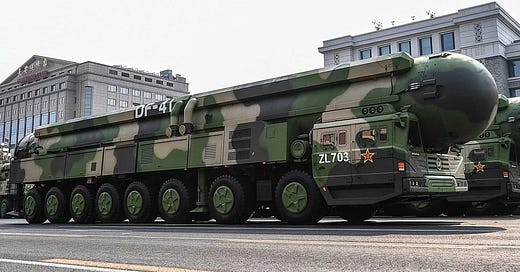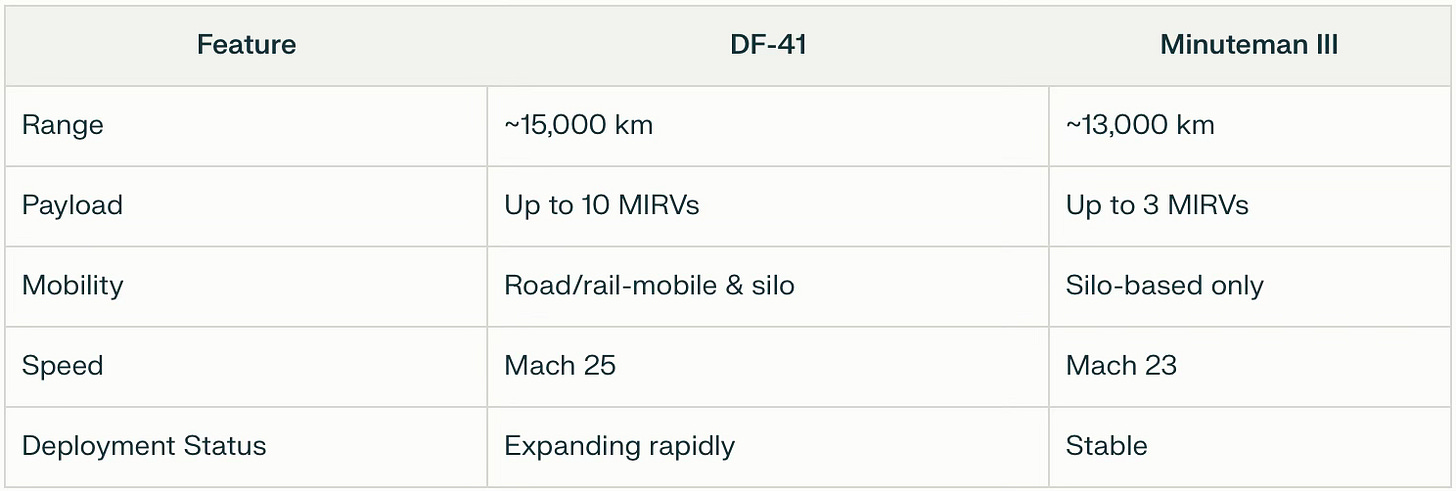Briefing: China's DF-41 Intercontinental Ballistic Missile
Strategic Implications for U.S. Security and the Evolving Global Nuclear Balance
Overview
The DF-41 (Dongfeng-41) stands as one of China's premier intercontinental ballistic missiles (ICBM) while serving as a fundamental component of its nuclear modernization strategy. The DF-41 missile is believed to have the ability to surpass 15,000 km in range and it possesses MIRV capabilities. These capabilities combined with mobile launch platforms strengthens China’s ability to execute a second-strike attack while creating substantial strategic issues for U.S. missile defense systems. The progression of this technology demonstrates Beijing’s strategic evolution towards a nuclear deterrent system that is both more reliable and harder to counter which modifies global arms power dynamics.
Development
The DF-41’s origins trace back to July 1986 under Project No. 204, though progress stalled until renewed focus in 1994. Prototype testing began in 2010, with the first successful flight test in 2012. The missile entered limited production in 2019, coinciding with its public debut at China’s National Day parade. Managed by the China Academy of Launch Vehicle Technology, the DF-41 integrates advanced solid-fuel propulsion while also overcoming earlier technical hurdles in guidance systems and reentry vehicle design. By 2022, China had deployed at least two DF-41 brigades, with silo construction projects in Inner Mongolia and Xinjiang signaling rapid expansion.
Fielding and Capabilities
Range: 12,000–15,000 km, covering the entire continental U.S., Europe, and Russia.
Payload: 6–10 MIRVs (estimated 20–150 kT yield per warhead).
Mobility: Launched from road-mobile TELs (Transporter-Erector-Launchers), rail platforms, or hardened silos, evading preemptive strikes.
Speed: Mach 25 (~30,000 km/h), reducing response time for targeted nations.
Accuracy: ~100-meter CEP (comparable to U.S. Minuteman III).
China’s ICBM arsenal has grown rapidly, with 300+ new silos under construction since 2021. The DF-41’s deployment aligns with a broader shift to a “launch-on-warning” posture, enhancing readiness but raising escalation risks.
Comparison to U.S. ICBMs
The DF-41 is often compared to the U.S. Minuteman III:
The DF-41’s mobility and MIRV capacity outmatch the aging Minuteman III, though the U.S. plans to field the LGM-35 Sentinel by 2030 to close this gap.
Concerns for the United States
Survivability: Road-mobile launchers complicate preemptive targeting.
MIRV Overload: A single DF-41 could overwhelm U.S. missile defenses (e.g., GMD system).
Nuclear Buildup: China’s warhead stockpile may grow to 1,500+ by 2035 (up from ~500 in 2023), challenging U.S. strategic superiority.
Escalation Risks: A “launch-on-warning” doctrine increases the likelihood of miscalculation during crises.
The Pentagon’s 2023 China Military Power Report highlights the DF-41 as a critical factor in China’s bid to deter U.S. intervention in regional conflicts (e.g., Taiwan).
Conclusion
Through its development of the DF-41 missile China showcases its strategic nuclear modernization efforts while moving to position itself as an equal nuclear competitor to the United States. China’s DF-41 missile system integrates extended range capabilities with mobile deployment and MIRV technology which disrupts U.S. missile defense strategies and indicates a move toward nuclear balance in the Indo-Pacific region. For the U.S., this necessitates:
Accelerating the Sentinel ICBM program.
Strengthening alliances (e.g., AUKUS) to counterbalance China’s capabilities.
Engaging in arms-control dialogues to mitigate destabilizing arms-race dynamics.
The DF-41’s proliferation underscores the urgent need for adaptive strategies to address evolving 21st-century threats.
Sources: U.S. Department of Defense reports, Federation of American Scientists, CSIS Missile Defense Project.





